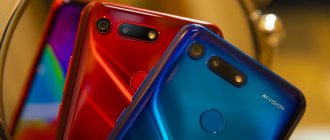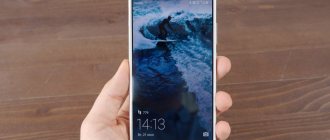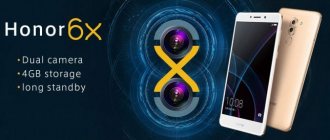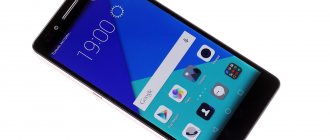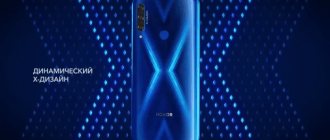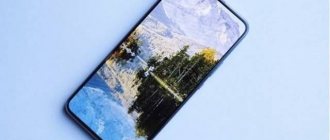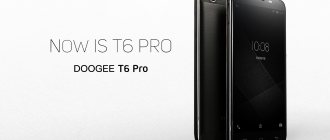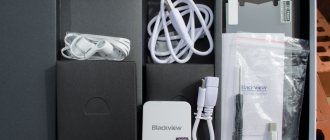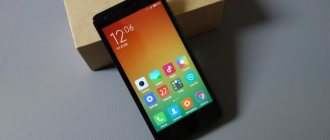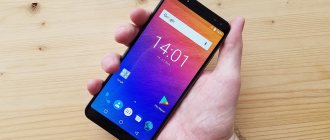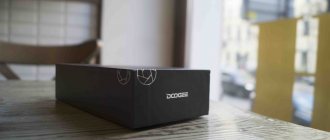This is another iPhone X clone with a wild price
In the 2017/2018 season, only 3 companies decided to release a smartphone with their own design, and only did it more than once: Xiaomi with its Mix 2s , OPPO Find X and the Sharp - that’s all we deserve.
Huawei , which trolled Apple for its unibrow, went the beaten path. The designers pretended to work - but it would be better if they didn’t do it. The hybrid of a unibrow and a touch pad under the screen looks strange. And it's inconvenient!
Apple made a bet on gestures, and all Android brands followed suit, combining them with on-screen navigation keys and a fingerprint scanner on the back. It's convenient - it's always at hand.
Why is there a scanner under the screen? And it would be nice if it were just a scanner combined with a Home button! Huawei's flagship has a full-fledged touch panel that works on a principle familiar to readers, borrowed from the iPhone .
The idea was good as long as smartphones were made of metal and there was little space around the button. When it is not there, your finger constantly hits the screen, creating unnecessary problems. You can enable on-screen keys. But then the scanner will interfere even more.
A smartphone for midgets? Maybe. Only the combination of metal, perfectly smooth glass and right angles prevents the Huawei P20 Pro without a case and with a small palm.
It simply slips out of your hands, including because of the glass, dimensions, lack of ergonomic elements and small thickness. In my opinion, the P20 Pro should be called the “Slipperiest Smartphone”. Even Mi 8 and ZUK 2 / Edge .
But more and more geek users are writing that it’s time to increase the thickness. And they choose gaming smarts.
Smartphone design
The Huawei P20 Pro body is made of glass and metal. The gradient finish, going from blue to purple with a hint of green, looks amazing, but the glass surface does pick up fingerprints.
At the top of the 6.1-inch OLED screen (2240 x 1080) is an iPhone X-style eyebrow that makes the icons, battery percentage and time appear slightly compressed and smaller than usual. However, the software allows you to hide this “eyebrow” by turning on the standard notification panel in the settings.
At the opposite end of the screen is a super-fast fingerprint scanner. But you can unlock your Huawei smartphone faster using the convenient facial recognition feature.
The P20 Pro is IP67 certified, although there is no 3.5mm headphone jack. There is support for Qualcomm's AptX HD, which improves the quality of wireless audio over Bluetooth, however, the phone uses Bluetooth version 4.2 instead of Bluetooth 5.
Huawei processors are becoming a problem
We can say that it’s time to get used to the typical design, and the days of unique mobile phones of the push-button era can no longer be returned. Why not then unify the “guts” of the platform, playing with combinations of peripherals and software?
Users will get used to it, programmers will be able to focus their efforts on optimizing the software, and we will finally see a normally working, fully functional Android. Then we can talk about the upcoming victory over iOS.
In fact, there are enough problems even when working with Qualcomm . So much so that many vendors have abandoned the use of potentially cheaper and more productive MediaTek when working with multimedia (at least in terms of price/performance ratio in certain scenarios).
So-so result compared to Snapdragon 845
And here is Huawei with its Kirin. There is no doubt that healthy competition is necessary, and Huawei can afford to develop the mobile platform in-house. After all, we use almost everything from the company’s equipment when connecting to a home or mobile network.
But software becomes a problem, because only the largest software developers can afford to support optimization for 3-4 platforms. Therefore, a battery with a larger capacity than its competitors did not become a panacea for the P20 Pro.
Flowers: microlags and software glitches, “battery waste” optimized for other application platforms.
Berries: crazy overheating and wild power consumption when processing 3D graphics. In a couple of minutes the back cover heats up to 46 degrees ! The operating time of the P20 Pro in this mode is the shortest among all flagships: only 3 hours versus 5 for the Samsung S9+ or 6 for the OnePlus 6 .
So you won’t be able to see the notorious “parrots” and endless productivity. Increasingly heavier 2D platformers on this model cause rapid overheating and clock drops. It would be worth introducing “water cooling”, like gaming smartphones with Qualcomm Snapdragon 845 .
Huawei P20 and P20 Pro test: did someone say "iPhone X"?
With the iPhone X design, Apple appears to have touched a nerve and ignited a passion for imitation among Chinese and Taiwanese manufacturers. Otherwise, there is nothing to explain the fact that the Far Eastern iPhone X clones, in which you can see notches on the screens almost everywhere, are sometimes wider and sometimes narrower.
Now, with the P20 and P20 Pro models, such an industry giant as Huawei, which has established itself in the Western market as a premium manufacturer, is jumping on the same train. She presented two very good Android smartphones with clear reminiscences of the iPhone X. But, unlike the device with the Apple logo, the fingerprint scanner is located under the display.
We find that Huawei has already proven with last year's Mate 10 Pro that it has its own character, but nevertheless the P20 and P20 Pro are gorgeous and above all stand out for their excellent workmanship. The devices lie in the hand as comfortably as possible and do not have any interfering gaps.
Meanwhile, it couldn’t do without the annoying Apple-style notch
A lot of important things were forgotten in the race
As with many other things. Little things show that Huawei was in a hurry when developing a smartphone that was supposed to show who’s boss. The same reason explains the incredible abundance of materials on all kinds of resources. The brand war leads to disastrous results.
A nuance: of all the brands, only Xiaomi manages to produce adequate smartphones in response to Apple ( Mi 5s Plus ). Only thanks to low prices and luck. Other vendors either waste a lot of time or create pretty lousy copies.
It may seem that Bluetooth 5.0 is not needed today. But when music in wireless headphones discharges the Huawei flagship 2 times faster than some OnePlus , it becomes uneasy.
For the sake of decency, we could also remember about wireless charging. But it remains for Huawei Mate 10 Porshe Edition .
The absence of accelerated communication technologies is also surprising. The actual transmission speed of the P20 Pro modem is inferior to devices based on Snap 845. Unpleasant.
Why do you need an Android smartphone that cannot be flashed?
Many users support the idea that Android 's EMUI is one of Huawei's most important problems. Most competitors managed to experiment and abandon their own developments in favor of “pure” Android.
Only Xiaomi and Huawei remain. Let's not forget that the first one is, in fact, a software developer, while Huawei engineers primarily worked on hardware solutions.
This may well explain the noticeable lags in earlier versions. Forgivable? Of course, if the update comes every 2-3 weeks, like Xiaomi. But things are bad .
This is expressed in the speed of operation and the smoothness of the interface. And the minimal difference between EMUI and stock Android: in fact, it is a launcher, a visual shell for displaying the desktop and settings.
It would be great to install a custom bootloader and an alternative system on this potentially interesting phone. I think the smartphone would become noticeably more interesting.
Since September 2020, it is impossible to unlock the bootloader on Huawei P10/P20/P20 Pro, get root and install custom recovery. Delirium that limits functionality.
This is prohibited for the same reasons as Xiaomi. But the latter allow any intervention according to the instructions, even a “brick” can be lifted. In the case of Huawei, any manipulation is prohibited.
Why then use Android at all if you deprive the user of editing it? And marketers manage to make a “feature” out of this political decision, saying that the smartphone receives additional protection.
Bigger is not always better, and cameras are great proof
So, deprived of the main advantage of Android over other operating systems, users can rely only on the camera capabilities. DxO's ratings (the P20 Pro has the highest) were already wrong with the Xiaomi Mix 2s and Mi 8.
By the way, Huawei marketers have already been caught with fraud, trying to pass off photos from a DSLR camera as photos taken using the P9 smartphone. Many managed to believe it, because the device was released with the support of Leica.
This time the vendor used heavy artillery, sending out free samples to all possible sources on the Internet. The result is in Google. Almost every smartphone review talks about the P20 Pro's unique camera capabilities and calls it the "Best Mobile Camera."
The 3-camera system is built rather strangely. It’s not for nothing that all the reviews focus so much on laser focusing, which can be found even in cheap “Chinese” ones.
So what is there? The front camera is equipped with a 24 megapixel without stabilization with an f/2.0 . A similar solution has been floating around since the days of OnePlus 3T . There was time to make sure that without stabilizing the front camera, the size of the matrix does not matter! Live selfies will be very difficult to get.
Even with anti-aliasing turned off, the camera unpleasantly “improves” the photo. “Soap” and aberrations in all their glory
The main hype around Huawei P20 Pro is dedicated to the main camera, which consists of 3 modules:
- 8 MP – color with 3x zoom and optical stabilization, f/2.4 ,
- 40 MP - color, without stabilization, f/1.8 ,
- 20 MP - black and white, without stabilization, f/1.6 ,
- color temperature sensor
What's wrong here? The module with magnification turns out to be the main and only stabilized one, which means it is the one that influences the final result of the combination if stabilization is necessary. Therefore, in the hands of a professional, the P20 Pro works wonders by the standards of Chinese smartphones.
And it easily falls behind if it falls into direct real comparison with another flagship without the use of additional means. This smartphone is definitely not for shooting in automatic mode.
Batteries and autonomy
Apple smartphones have never been equipped with capacious batteries, but they were successful due to their software and optimization of energy consumption. iPhone X is no exception - the device received a 2716 mAh battery. The same battery is installed in the iPhone 8 Plus.
The kit includes a 5V/1A adapter, which is not capable of charging quickly - from zero to 20% in 30 minutes. The result is not impressive and even disappointing, but the smartphone can be charged faster. So that it works via USB Type-C. To do this, you will need a USB Type-C to Lightning adapter and an adapter from a MacBook or even a Google Pixel 2. Using a fast charging adapter guarantees increased speed - in 30 minutes the phone will charge from zero to 45%, although this is not the fastest charging, considering the that 45% in iPhone X is only 1222 mAh.
Testing of the smartphone by the GSMArena studio showed that the iPhone X on a full charge will provide (the backlight brightness is set to 200 nits, which is equal to 30%):
- 19 hours of calls on a 3G network;
- 9.26 hours of surfing the Internet;
- 12 hours of video playback.
Standard result for smartphones 2017-2019. Considering the battery capacity of 2716 mAh, autonomy is impressive.
Huawei P20 Pro is equipped with a 4000 mAh battery, which is rare in TOP models. When testing autonomy, the following results were obtained:
- 20:56 hours of communication on a 3G network;
- 14:30 surfing the Internet;
- 13:14 hours of video playback.
The display brightness is set to 200 nits – 48.5% of the total backlight brightness. Unlike the iPhone X, the Huawei P20 Pro comes out of the box with a fast charging adapter - with it, the phone charges from 0 to 58% in half an hour, a full cycle lasts 90 minutes. Considering the battery capacity of 4000 mAh, the results are excellent.
Huawei is not Google. Artificial intelligence Kirin - raw
Everything would be fine, but it is tied to the work of the artificial intelligence of the processor and desperately tries to correct the photos. Yes, the most important thing is that due to its low characteristics it only works in good lighting.
As a result, the combination of excellent color and b/w cameras loses details in motion, blurred edges and overly beautiful faces are the norm for the Huawei P20 Pro . Machine learning algorithms can take great night photos, but they lose detail.
Left - Huawei P20 Pro
Everything is possible with Huawei P20 Pro . So the Huawei developers, with the help of a useless “telephoto” module, ruined everything in one fell swoop. Why can't the main module be stabilized? Mystery.
Other advantages of using artificial intelligence only cause yawning: translation of texts without the Internet, prediction of user requests and other similar “tricks”. Everything that Android can handle even on the cheapest Redmi.
Another marketing ploy.
Performance and processors
The devices use the most powerful chipsets at the time of flagship release. Let's start with Apple - the iPhone X received an Apple A11 Bionic processor with 6 cores and the first video accelerator, which was developed directly by Apple (PowerVR graphics units were previously used). Also, the phone only has 3GB of RAM.
The new A11 Bionic chip uses two powerful Monsoon cores with a frequency of 2.4 GHz, which are 25% more powerful than the previous Hurricane blocks in the Apple A10 Fusion. The chipset also features energy-efficient 2.34 GHz Mistral cores – they are 75% faster than previous low-performance Zephyr units and at the same time have lower power consumption. Plus, the processor uses a 2-core dedicated unit responsible for machine learning, thanks to which the phone performs routine tasks faster.
Testing the iPhone X in popular benchmarks showed the following results.
GeekBench 4.1 (single-core mode)
GeekBench 4.1 (multi-core)
Let's remember the test results: 4256 points in single-core mode; 10215 points – in multi-core. These are amazing results that speak of Apple's success in creating its own graphics video accelerators.
Overall performance is displayed in the Antutu 7 benchmark. The results are obtained from the official Antutu website:
Clearly, the iPhone X is a powerful flagship that remains extremely energy efficient.
Huawei P20 Pro is equipped with SoC Kirin 970, made using 10nm technology. It consists of 8 cores: 4xCortex-A73 2.4 GHz, 4xCortex-A53 1.8 GHz + Mali-G72 MP12. The RAM here is 2 times larger - 6 GB. I’ll add that HiSilicon processors have a weak point - the Mali graphics core, which drags down the fairly technologically advanced Kirin 970. Because of it, the overall speed when working with graphics drops, as evidenced by the test results.
GeekBench 4.1 (single-core mode)
GeekBench 4.1 (multi-core)
Antutu 7
What we see as a result: in Single-Core mode in the GeekBench benchmark, the Kirin 970 is more than 2 times inferior to the Apple A10 Fusion. The lag is reduced in multi-core mode, although there is still a gap between the chipsets. And all because of the Mali video accelerator.
The overall performance displayed in Antutu 7 is strong, but in any case, the winner is the Apple iPhone X.
